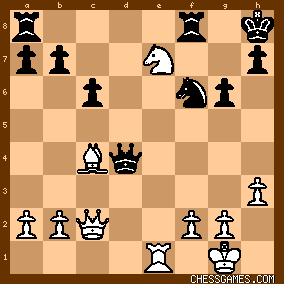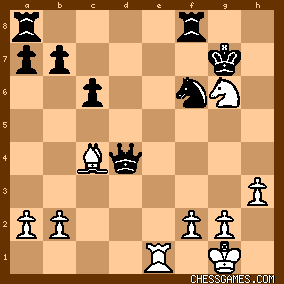|
< Earlier Kibitzing · PAGE 3 OF 3 ·
Later Kibitzing> |
| Feb-08-06 | | Jacobb: YouRang- i thikn you are correct in saying that whhite could then recapture with the knight allowing a more comfortable pawn structure,although i dont see how this move makes blacks game any worse,especially because if any thing the king will be available for defense of the f6 square,stopping a direct mating attack. but then again what the hell do I know :) |
|
| Feb-08-06 | | Ernest van der Sar: <Marvol> Or "This is what you did see, but not considered the best move, as it is not winning" |
|
| Feb-08-06 | | thegoodanarchist: "Patzer sees check, Patzer gives check." - Bobby Fischer, referring to a bad move of his own which spoiled a nice position. "Always check - it might be mate!" - A russian chess axiom. How to resolve the two? If check leads to mate, play it. If it leads to a bad position, don't play it. But you knew that already, right? |
|
| Feb-08-06 | | dakgootje: Missed the puzzle though even if i had seen it up to move 22 i wouldnt calculate any further as i probably would consider the advantage for white too small for a possible solution. Maybe whites 30th move would have made a nicer puzzle... |
|
| Feb-08-06 | | YouRang: <Jacobb> I agree that there isn't much difference between 21...Kh8 and 21...Kg7. My point is that Kg7 offered no great improvement over Kh8 such that Kh8 should be considered a "mistake" (as <chessnewbie> suggested). I assume that Golz considered both moves on move 21, and found Kh8 to be preferable -- I was merely speculating on his reasons. :) |
|
| Feb-08-06 | | Sami Jr: What a game by Kholmov! Move 20 I could see, but the resignation after white's 30th move was tougher. Fancy that the little pawn on g4 is the key to victory after obtaining blacks castle in checking the king on move 33 g5 if 30...Rxf6. If there's 2 things I have learned since joining this forum, it's: 1) Never rule out the potential of a gambit or sacrifice and 2) Don't underestimate the power of a pawn. |
|
Feb-08-06
 | | al wazir: I think 19. Nxf7 (my choice) also wins. If 19...Rxf7 then 20. Qxf5. If 19...Bxc2 then 20. Nxd6+ Kh8 21. Re7. Black's best is 19...Qxg3 20. Nd6+ Kh8 21. Nxf5 Qg5 (21...Qc7 22. Re7) 22. Nd6 Qh5 23. Re7. White's attack looks unstoppable. |
|
| Feb-08-06 | | Greginctw: Much simple. Strong players for example me see it in one or a few seconds. it was cute at first. now its tired. |
|
| Feb-08-06 | | YouRang: <al wazir> In your 19. Nxf7 Qxg3 line, how do you respond if 21...Qf4? |
|
| Feb-08-06 | | shirova: < YouRang: <al wazir> In your 19. Nxf7 Qxg3 line, how do you respond if 21...Qf4? > Hehe, the response is no reply! |
|
Feb-08-06
 | | al wazir: 22. Ne7, threatening 23. Qxg6 hxg6 24. Nxg6+. If 22...Rae8 then 23. Re3, threatening 24. Rf3. |
|
Feb-08-06
 | | Richard Taylor: I saw 19. Qxf5 immediately but I had to find win as the annoying 19 ... Qxg3 needs to be combatted If 19. ... Qxg3 20. Qxf6 is winning.
So 19. ... gxf5 and then which check? - I worked out that 20. Ne4+ wins as if 20. ... Qxg3 21. Nf6+ and if now Kg7 22. Nh5+ and wins. The game as played also is winning for White. |
|
| Feb-08-06 | | YouRang: <al wazir> Thanks for the reply. I guess I'm not understanding you line... Suppose we play 19...Qxg3 20. Nd6+ Kh8 21. Nxf5 Qf4 22. Ne7 as you suggest, then black plays 22...Qxd4 [diagram:White move]

click for larger view
Now you play 23. Qxg6 hxg6 24. Nxg6+ Kg7 [diagram:White move]

click for larger view
I am failing to see how white is winning. :( |
|
| Feb-08-06 | | chessic eric: <al wazir> after a cursory look at 19.Nxf7,Rxf7 20.Qxf5,Kf8!? I don't see a line approaching the succes of that seen in the game. If 21.Qe6 multiple exchanges seem to fizzle white's play. White has won a pawn, but black can use the f file well with 21...Nd5 after white moves the queen. |
|
| Feb-08-06 | | chessic eric: <al wazir> in your line, after 19.Nxf7,Qxg3 20.Nd(h)6+,Kh8 21.Nxf5 black does well to play 21...Qc7 imo. After 22.Re7 black plays either 22...Qf4 - when the white rook takes away the e7 square for the knight, and I can't see any sacrificial play on g6/h7 - or 22...Qd8, in which case either the knight or the rook falls. |
|
Feb-08-06
 | | al wazir: <chessic eric>: I'll take this position a pawn up any day. But see below. <YouRang>: Of course I don't play 23. Qxg6 after 22...Qxd4. That only works if the ♕ doesn't move. Instead I would play 23. Nxg6+. After 23...hxg6 24. Qxg6 Qxc4 25. Re7, white threatens mate on g7. But then follows 25...Qg8 26. Qh6+ Nh7, and the attack stalls. So I guess you're right, it's no good. |
|
Feb-08-06
 | | al wazir: Actually, 23. Be3 is a better move than Nxg6. The threat now is 24. Bxg6 hxg6 25. Nxg6+ or maybe Qxg6. But I don't see a win. |
|
| Feb-09-06 | | YouRang: <al wazir> Thanks again. Normally I find your analysis to be pretty solid, but in this case I couldn't find a win at all after 19. Nxf7. I figured you must have seen something that I was missing. :) |
|
| Feb-10-06 | | Fezzik: I have no quibbles with 30.Nf6! being beautiful.
However, I don't see how Kholmov or any other player could have predicted Black's moves after reaching a losing position by move 24. (For example, 26...b5? How does that fit in with the combination?) I don't think it was a coincidence that Golz played on until move 30 and not move 29 or 31. I'm willing to bet that Kholmov saw the queen exchange winning material and maintaining an attack. He almost certainly made his decision based on the position after move 24, and not move 30. |
|
| Feb-10-06 | | patzer2: White's 19. Qxf5!! sets up a discovered check with a neat follow-up in-between move (a.k.a Zwischenzug or intermezzo) in 21. Nxf6! to win a piece with decisive advantage. |
|
| Feb-13-06 | | schnarre: <patzer2> That about sums it up! |
|
| Jul-17-08 | | The Ninth Pawn: From Game Collection: The Ninth Pawn's Chess Course : Moving on, we see that in Kholmov vs W Golz, 1956 , White uses the ZWISCHENZUG (IN-BETWEEN MOVE) 21. ♘e4x♘f6+! before recapturing with 22. f2x♕g3. In this way White gets a whole Knight more than he would otherwise. |
|
| Jul-18-08 | | The Ninth Pawn: From Game Collection: Periodic Table of Tactical Elements: IBM (Z) : In Kholmov vs W Golz, 1956 , the automatic recapture of the queen on 21 move would do no good, but instead 21. ♘e4x♘f6+. |
|
Apr-01-11
 | | FSR: "Traditional" is 17...Bh5 18.Rh3 Bg6 19.Qxg6!! hxg6 20.Bx7+! Rxf7 21.Rh8+! Kxh8 22.Nxf7+ Kg8 23.Nxd6 Rd8 24.Re6 with a winning endgame, as in a game of Marovic's. |
|
Feb-18-17
 | | tpstar: Nice middlegame puzzle, and nice endgame puzzle. <"Always check - it might be mate!"> AIEEE! |
|
 |
 |
|
< Earlier Kibitzing · PAGE 3 OF 3 ·
Later Kibitzing> |





